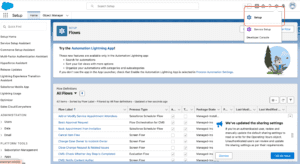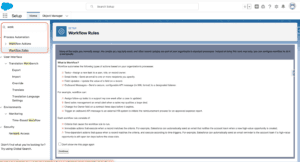In our previous blog post we had discussed about Introduction to Duplicate Management in Salesforce.In these blog post we discuss about What is Work Flows in Salesforce
Contents
- 1 What is work flows in Salesforce
- 2 Understanding Workflows in Salesforce
- 3 Components of Salesforce Workflows
- 4 Criteria for Workflow Rules
- 5 Workflow Actions Explained
- 6 Types of Workflow Actions
- 7 Implementing Field Updates
- 8 Setting Up Email Alerts
- 9 Task Creation Automation
- 10 Using Outbound Messages
- 11 Best Practices for Workflows
- 12 Common Use Cases of Workflows
- 13 Limitations of Salesforce Workflows
- 14 Future of Workflows in Salesforce
- 15 Conclusion
What is work flows in Salesforce
What is Work Flows in Salesforce
Workflow is the series of activities that are necessary to complete a task. Each step in a workflow has a specific step before it and a specific step after it, except for the first and last steps.
Understanding Workflows in Salesforce
First things first, what exactly are workflows in Salesforce Simply put, workflows are automated processes that trigger specific actions when certain conditions are met. Think of them as a set of instructions that tell Salesforce what to do when something happens. This automation helps businesses save time, reduce errors, and ensure consistency in their operations.
Components of Salesforce Workflows
Workflows in Salesforce have two main components: workflow rules and workflow actions.
Workflow Rules
Workflow rules are the criteria that trigger the workflow. They define the “if” part of an “if-then” statement.
Workflow Actions
Workflow actions are what happens when the criteria of a workflow rule are met. These can include tasks like updating a field, sending an email, creating a task, or sending outbound messages.
Creating Workflow Rules
Creating a workflow rule in Salesforce is a straightforward process. Here’s a step-by-step guide:
- Navigate to Workflow Rules: Go to the Setup menu,

- Process Automation, and select Workflow Rules.

- Create a New Rule: Click on ‘New Rule’ and choose the object (like leads, accounts, etc.) you want to associate with this workflow.

- Define Criteria: Set the conditions that will trigger the workflow. This could be based on field values, formulas, or other conditions.

- Specify Actions: Choose the actions that should occur when the criteria are met.
- Activate the Rule: Once everything is set up, activate the workflow rule to start automating tasks.
Example of a Workflow Rule
Imagine you want to notify your sales manager every time a lead is qualified. You’d set the criteria to check if the lead status equals “Qualified” and then configure an email alert to send to the sales manager.
Criteria for Workflow Rules
When setting up workflow rules, you’ll encounter two primary criteria options:
Rule Criteria Options
- Field-Based Criteria: Triggers based on the value of a specific field.
- Formula-Based Criteria: Uses Salesforce formulas to determine if the criteria are met.
Evaluation Criteria
This determines how often the rule is evaluated:
- Created: Only when a record is created.
- Created and Every Time It’s Edited: Every time a record is created or edited to meet the criteria.
- Created and Any Time It’s Edited to Subsequently Meet Criteria: Only when a record is edited to meet the criteria for the first time.
Workflow Actions Explained
Workflow actions can be either immediate or time-dependent.
Immediate Actions
These actions occur as soon as the workflow rule criteria are met.
Time-Dependent Actions
These actions are scheduled to happen after a specified time period once the workflow rule criteria are met.
Types of Workflow Actions
Salesforce workflows can perform a variety of actions to automate your business processes:
Field Updates
Field updates automatically change the value of a field on a record. For example, you can update a lead status from “New” to “Contacted” once an initial email is sent.
Email Alerts
Email alerts send emails to designated recipients based on certain events or updates. This is great for keeping your team informed about critical changes or actions needed.
Task Creation
Automating task creation ensures that important tasks aren’t forgotten. For example, when a new lead comes in, you can automatically create a task for a sales rep to follow up.
Outbound Messages
Outbound messages send data to external systems via SOAP API when specific criteria are met. This is useful for integrating Salesforce with other systems your business might use.
Implementing Field Updates
Field updates are straightforward to implement. Here’s how you can set them up:
- Select Field Update: In the workflow rule setup, choose ‘New Field Update.’
- Define the Update: Specify which field to update and what the new value should be.
- Save and Activate: Save your changes and activate the workflow rule.
Setting Up Email Alerts
Email alerts are crucial for keeping everyone in the loop. Here’s a quick guide to setting them up:
- Create Email Alert: In the workflow rule setup, select ‘New Email Alert.’
- Define Recipients: Choose who should receive the email.
- Compose the Email: Write the email template and subject.
- Save and Activate: Save your email alert and activate the workflow rule.
Task Creation Automation
Automating task creation can help ensure that nothing slips through the cracks.
- Create New Task: In the workflow rule setup, select ‘New Task.’
- Define Task Details: Specify the task subject, due date, and who it should be assigned to.
- Save and Activate: Save your task and activate the workflow rule.
Using Outbound Messages
Outbound messages are useful for sending data to other systems. Here’s how to configure them:
- Create Outbound Message: In the workflow rule setup, select ‘New Outbound Message.’
- Specify Endpoint: Define the external system endpoint where the data should be sent.
- Map Fields: Map the Salesforce fields to the fields in the external system.
- Save and Activate: Save your outbound message and activate the workflow rule.
Best Practices for Workflows
To get the most out of Salesforce workflows, keep these best practices in mind:
Simplifying Workflow Rules
Keep your workflow rules as simple as possible. Complex rules can be hard to manage and troubleshoot.
Testing Workflows
Always test your workflows in a sandbox environment before deploying them to your live Salesforce instance. This helps catch any issues before they affect your actual data.
Common Use Cases of Workflows
Here are some common scenarios where workflows can make a big difference:
Lead Management
Automatically assign leads to sales reps based on specific criteria, ensuring that leads are handled promptly.
Sales Processes
Send alerts when deals reach specific stages, helping your sales team stay on top of their game.
Customer Support
Automate the creation of support tasks when new cases are logged, ensuring timely responses to customer issues.
Limitations of Salesforce Workflows
While workflows are incredibly useful, they do have some limitations:
Scalability Issues
As your organization grows, managing a large number of workflows can become challenging.
Complex Logic Handling
For more complex logic, you might need to use Salesforce’s Process Builder or Flow, which offer more advanced capabilities.
Future of Workflows in Salesforce
Salesforce is gradually shifting from workflows to more advanced tools like Process Builder and Flow.
Transition to Process Builder and Flow
These tools offer greater flexibility and power, allowing for more complex automation and integration.
What to Expect
While workflows will continue to be supported, consider transitioning to Process Builder and Flow for new automation needs.
Conclusion
Workflows in Salesforce are a powerful way to automate business processes, save time, and ensure consistency. By understanding and implementing workflows effectively, you can significantly enhance your organization productivity and efficiency.
We want to more about What is Workflows in Salesforce Click HERE
In our next blog post we will discuss about What is Process Builder in Salesforce

4 thoughts on “What is Work Flows in Salesforce”